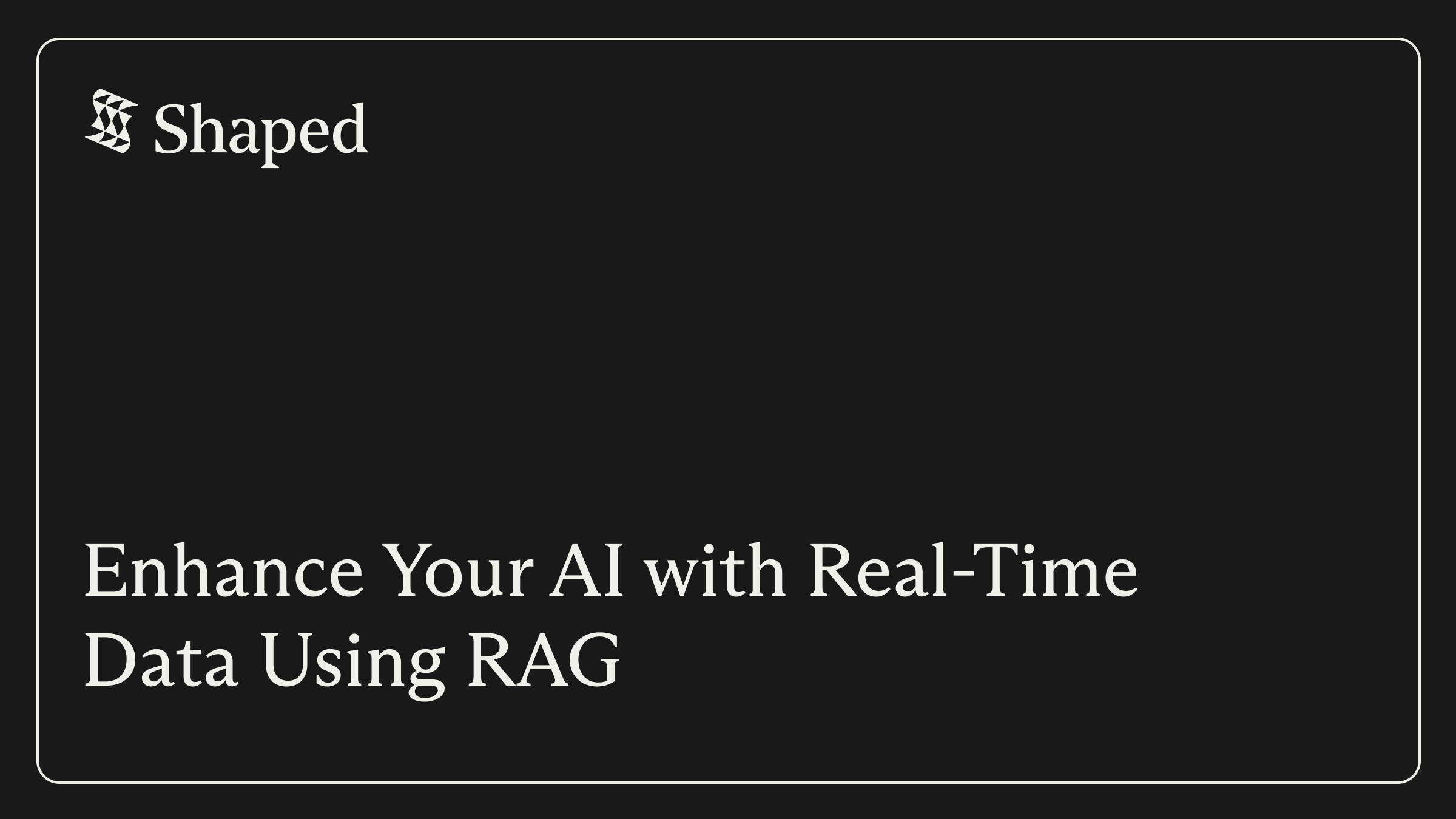In a world where personalization and relevance are paramount, AI-driven systems often struggle to handle real-time data and maintain up-to-date information.
Traditional models, while powerful, are limited by their reliance on static training data and their inability to adapt quickly to new or unstructured data. As organizations face knowledge-intensive tasks like answering complex queries, providing personalized recommendations, or generating content, the cost of maintaining large, constantly updated datasets becomes a significant barrier.
However, there is a solution that bridges the gap between generative models and the vast pools of external knowledge — retrieval-augmented generation (RAG).
Why Real-Time Personalization is Challenging
As AI-driven personalization becomes a core part of user experience, many organizations face significant obstacles when trying to scale personalization efforts. The complexity lies in the infrastructure needed to process and analyze data in real-time.
For most businesses, the cost of building and maintaining such systems, especially without a dedicated data science team, is overwhelming.
A common bottleneck in real-time personalization is the cold start problem, which occurs when AI models struggle to provide relevant recommendations or responses for new users, products, or content due to a lack of historical data.
Traditional AI models depend on large datasets, often requiring weeks or months of training to adapt to new inputs. This time lag in adapting to user input or changes in data sources can significantly hinder the user experience, making it harder to deliver relevant, up-to-date responses when users need them most.
Another challenge is the computational and financial costs associated with continuously updating models to reflect current information. Businesses often have to weigh the cost of maintaining large training data pipelines, running search engines, and managing the infrastructure needed to keep AI systems responsive.
This constant need for fine-tuning and the complexity of integrating data from various external sources (e.g., knowledge graphs, vector databases) makes it difficult for businesses to experiment quickly and iterate at the pace required for competitive AI-driven personalization.
Additionally, data silos and fragmented structured data further complicate the process. Unifying various internal representation systems with external data and models requires overcoming vendor lock-in and managing compatibility across multiple platforms and data sources.
How Retrieval-Augmented Generation Works
Retrieval-Augmented Generation (RAG) combines the power of large language models (LLMs) with an information retrieval component to enhance AI responses.
Instead of relying on a model trained solely on static datasets, RAG systems enable AI to retrieve relevant information from external data sources in real-time, allowing the model to respond to user queries with more contextually accurate and up-to-date answers. Here’s how it works in practice:
Fetching Real-Time Data
The first step in a RAG system is the retrieval process. When a user query is made, the AI model first identifies relevant data sources that can help provide a better answer. These data sources can include vector databases, knowledge graphs, or even unstructured web search results. By leveraging semantic search techniques, the system searches through massive datasets to retrieve relevant content that accurately answers the query.
For example, when a user asks a question about a specific product, the system might pull data from a product catalog, reviews, and external sources to gather the most up-to-date and relevant information. The system can also retrieve domain-specific details that ensure the answer is not only accurate but also tailored to the context of the user’s request.
Combining Retrieved Data with User Input
Once the relevant data is retrieved, it’s combined with the user input to generate a response. This augmented prompt enables the model to generate engaging responses tailored to the user’s query, leveraging real-time insights rather than relying on outdated information. By combining structured data from databases with unstructured data from documents or external sources, the system provides a richer, more detailed response than what a traditional, static model would generate.
For instance, if a user asks for a personalized product recommendation, the AI doesn’t just rely on pre-trained models. It pulls real-time data from the catalog and even customer reviews to present options that are most relevant to the user's preferences, providing a truly dynamic recommendation.
Plug-and-Play Setup
One of the main advantages of RAG is that it integrates seamlessly with existing data infrastructures. Shaped’s platform, for example, can connect to a variety of data sources, such as internal representation systems or third-party platforms like S3 and BigQuery, using API-first integration. This flexibility enables the easy addition of real-time data retrieval to existing systems without requiring infrastructure overhauls.
RAG implementation is designed to be scalable. Businesses can start with smaller use cases, such as integrating real-time recommendations for a specific product category, and gradually expand to include knowledge-intensive tasks like customer support or content generation across multiple touchpoints.
Fine-Tuning: Optimizing Responses
Unlike traditional models that require frequent retraining on massive datasets to improve accuracy, RAG systems can fine-tune answers on the fly. As the system retrieves relevant snippets from up-to-date sources, it adjusts the responses based on the most recent information, ensuring that answers remain fresh without requiring constant updates to the model itself.
For example, in an e-commerce setting, a RAG model can generate product recommendations based on recent user behavior and inventory updates, all without the need to retrain the entire recommendation model. This drastically reduces both the computational costs and time required to maintain a high-performing personalization engine.
Use Cases and Applications of RAG
The power of retrieval-augmented generation (RAG) lies in its versatility and ability to enhance personalization across a variety of industries and applications.
E-Commerce
In the competitive world of e-commerce, personalization is crucial for driving sales and boosting conversions. RAG enables AI systems to surpass basic product recommendations, utilizing real-time data and external knowledge to suggest products based on the user’s current behavior, preferences, and even up-to-the-minute inventory updates.
For example, when a user browses a product, RAG can pull relevant content from various sources, such as reviews, product details, and real-time stock levels, to suggest the most relevant options. This results in a dynamic, engaging user experience that keeps customers coming back and increases the likelihood of conversion.
Media Companies
For media companies, delivering engaging answers and relevant content to users is a primary goal. With RAG, media platforms can provide personalized content recommendations by retrieving relevant documents or articles that match a user’s interests and viewing history. This ensures that users always have fresh, relevant content to engage with, increasing retention rates and overall user satisfaction.
For instance, a news website can use RAG to provide users with the latest articles based on their previous reading patterns or geographic location, pulling in information in real-time to present the most relevant stories at any given moment. The system can also adjust recommendations based on user queries, ensuring that content is continuously aligned with user interests.
Customer Support
RAG is especially valuable in customer support, where providing accurate, timely responses is critical. Instead of relying solely on static knowledge bases or scripted responses, RAG systems can retrieve relevant snippets from knowledge bases, manuals, or FAQs, delivering more precise, up-to-date answers to user inquiries.
For example, when a customer asks a support agent for troubleshooting advice, the AI can pull the latest documentation, user guides, or community answers to deliver a solution tailored to the specific problem. By retrieving relevant information from multiple sources, RAG ensures that support agents or automated chatbots always have access to the most current and relevant answers.
Content Generation
For content creators and marketers, generating high-quality, relevant content at scale can be a challenge. RAG enables AI to pull from both internal and external knowledge sources to generate content that is both relevant and engaging.
Whether it’s for blog posts, product descriptions, or social media content, RAG enables the integration of relevant facts, user input, and real-time data to create personalized content that resonates with the target audience.
For instance, a content marketing team can use RAG to automatically generate blog articles or product descriptions based on current trends and consumer preferences, ensuring that the content is both timely and aligned with the audience's needs. This can drastically improve efficiency while maintaining content quality and relevance.
Empower Your AI to Deliver Real-Time Personalization
By leveraging RAG systems, businesses can significantly reduce computational costs, increase user engagement, and create highly personalized experiences that are real-time adaptable.
Whether it’s for e-commerce, media, customer support, or content generation, RAG enables companies to integrate external data efficiently and deliver smarter, more relevant results, without the need for expensive and time-consuming retraining.
Shaped’s platform exemplifies how RAG systems can be seamlessly integrated into existing infrastructures, enabling teams to experiment rapidly, scale personalization efforts, and deliver results that drive engagement and satisfaction.
With Shaped, you don’t have to worry about the complexities of maintaining your own AI infrastructure. You can focus on retrieving relevant information, optimizing real-time personalization, and making data-driven decisions that accelerate growth.
Ready to enhance your AI with real-time data and retrieval-augmented generation? Start a free Shaped trial today.




